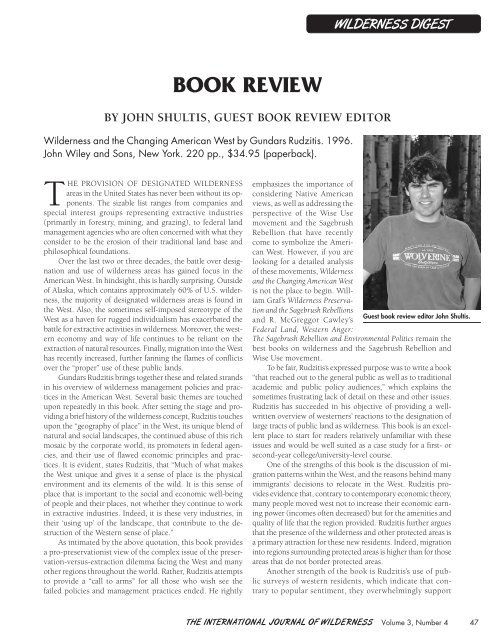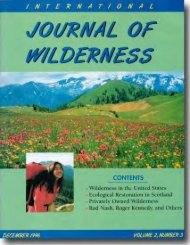Download full PDF - International Journal of Wilderness
Download full PDF - International Journal of Wilderness
Download full PDF - International Journal of Wilderness
You also want an ePaper? Increase the reach of your titles
YUMPU automatically turns print PDFs into web optimized ePapers that Google loves.
THE PROVISION OF DESIGNATED WILDERNESS<br />
areas in the United States has never been without its opponents.<br />
The sizable list ranges from companies and<br />
special interest groups representing extractive industries<br />
(primarily in forestry, mining, and grazing), to federal land<br />
management agencies who are <strong>of</strong>ten concerned with what they<br />
consider to be the erosion <strong>of</strong> their traditional land base and<br />
philosophical foundations.<br />
Over the last two or three decades, the battle over designation<br />
and use <strong>of</strong> wilderness areas has gained focus in the<br />
American West. In hindsight, this is hardly surprising. Outside<br />
<strong>of</strong> Alaska, which contains approximately 60% <strong>of</strong> U.S. wilderness,<br />
the majority <strong>of</strong> designated wilderness areas is found in<br />
the West. Also, the sometimes self-imposed stereotype <strong>of</strong> the<br />
West as a haven for rugged individualism has exacerbated the<br />
battle for extractive activities in wilderness. Moreover, the western<br />
economy and way <strong>of</strong> life continues to be reliant on the<br />
extraction <strong>of</strong> natural resources. Finally, migration into the West<br />
has recently increased, further fanning the flames <strong>of</strong> conflicts<br />
over the “proper” use <strong>of</strong> these public lands.<br />
Gundars Rudzitis brings together these and related strands<br />
in his overview <strong>of</strong> wilderness management policies and practices<br />
in the American West. Several basic themes are touched<br />
upon repeatedly in this book. After setting the stage and providing<br />
a brief history <strong>of</strong> the wilderness concept, Rudzitis touches<br />
upon the “geography <strong>of</strong> place” in the West, its unique blend <strong>of</strong><br />
natural and social landscapes, the continued abuse <strong>of</strong> this rich<br />
mosaic by the corporate world, its promoters in federal agencies,<br />
and their use <strong>of</strong> flawed economic principles and practices.<br />
It is evident, states Rudzitis, that “Much <strong>of</strong> what makes<br />
the West unique and gives it a sense <strong>of</strong> place is the physical<br />
environment and its elements <strong>of</strong> the wild. It is this sense <strong>of</strong><br />
place that is important to the social and economic well-being<br />
<strong>of</strong> people and their places, not whether they continue to work<br />
in extractive industries. Indeed, it is these very industries, in<br />
their ‘using up’ <strong>of</strong> the landscape, that contribute to the destruction<br />
<strong>of</strong> the Western sense <strong>of</strong> place.”<br />
As intimated by the above quotation, this book provides<br />
a pro-preservationist view <strong>of</strong> the complex issue <strong>of</strong> the preservation-versus-extraction<br />
dilemma facing the West and many<br />
other regions throughout the world. Rather, Rudzitis attempts<br />
to provide a “call to arms” for all those who wish see the<br />
failed policies and management practices ended. He rightly<br />
BOOK REVIEW<br />
BY JOHN SHULTIS, GUEST BOOK REVIEW EDITOR<br />
<strong>Wilderness</strong> and the Changing American West by Gundars Rudzitis. 1996.<br />
John Wiley and Sons, New York. 220 pp., $34.95 (paperback).<br />
emphasizes the importance <strong>of</strong><br />
considering Native American<br />
views, as well as addressing the<br />
perspective <strong>of</strong> the Wise Use<br />
movement and the Sagebrush<br />
Rebellion that have recently<br />
come to symbolize the American<br />
West. However, if you are<br />
looking for a detailed analysis<br />
<strong>of</strong> these movements, <strong>Wilderness</strong><br />
and the Changing American West<br />
is not the place to begin. William<br />
Graf’s <strong>Wilderness</strong> Preservation<br />
and the Sagebrush Rebellions<br />
and R. McGreggor Cawley’s<br />
Federal Land, Western Anger:<br />
WILDERNESS DIGEST<br />
Guest book review editor John Shultis.<br />
The Sagebrush Rebellion and Environmental Politics remain the<br />
best books on wilderness and the Sagebrush Rebellion and<br />
Wise Use movement.<br />
To be fair, Rudzitis’s expressed purpose was to write a book<br />
“that reached out to the general public as well as to traditional<br />
academic and public policy audiences,” which explains the<br />
sometimes frustrating lack <strong>of</strong> detail on these and other issues.<br />
Rudzitis has succeeded in his objective <strong>of</strong> providing a wellwritten<br />
overview <strong>of</strong> westerners’ reactions to the designation <strong>of</strong><br />
large tracts <strong>of</strong> public land as wilderness. This book is an excellent<br />
place to start for readers relatively unfamiliar with these<br />
issues and would be well suited as a case study for a first- or<br />
second-year college/university-level course.<br />
One <strong>of</strong> the strengths <strong>of</strong> this book is the discussion <strong>of</strong> migration<br />
patterns within the West, and the reasons behind many<br />
immigrants’ decisions to relocate in the West. Rudzitis provides<br />
evidence that, contrary to contemporary economic theory,<br />
many people moved west not to increase their economic earning<br />
power (incomes <strong>of</strong>ten decreased) but for the amenities and<br />
quality <strong>of</strong> life that the region provided. Rudzitis further argues<br />
that the presence <strong>of</strong> the wilderness and other protected areas is<br />
a primary attraction for these new residents. Indeed, migration<br />
into regions surrounding protected areas is higher than for those<br />
areas that do not border protected areas.<br />
Another strength <strong>of</strong> the book is Rudzitis’s use <strong>of</strong> public<br />
surveys <strong>of</strong> western residents, which indicate that contrary<br />
to popular sentiment, they overwhelmingly support<br />
THE INTERNATIONAL JOURNAL OF WILDERNESS Volume 3, Number 4 47










